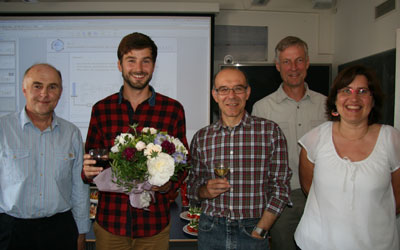Congratulations to Christopher Stowasser

Christopher Stowasser with his supervisor Thomas Blunier (right) and the committee members Robert Mulvaney, British Antarctic Survey (left), Valérie Masson-Delmotte, Lab. des Science du Climat et de L'Environnement (right) and Peter Ditlevsen (behind).
Congratulations to Christopher Stowasser from Centre for Ice and Climate who succesfully defended his PhD thesis on Thursday, June 27, 2013.
Titel and abstract here below. Full thesis will be uploaded here as soon as possible.
Continuous greenhouse gas measurements from ice cores
Ice cores offer the unique possibility to study the history of past atmospheric greenhouse gases over the last 800,000 years, since past atmospheric air is trapped in bubbles in the ice. Since the 1950s, paleo-scientists have developed a variety of techniques to extract the trapped air from individual ice core samples, and to measure the mixing ratio of greenhouse gases such as carbon dioxide, methane and nitrous oxide in the extracted air. The discrete measurements have become highly accurate and reproducible, but require relatively large amounts of ice per measured species and are both time-consuming and labor-intensive.
This PhD thesis presents the development of a new method for measurements of greenhouse gas mixing ratios from ice cores based on a melting device of a continuous flow analysis (CFA) system. The coupling to a CFA melting device enables time-efficient measurements of high resolution simultaneously with measurements of many chemical proxies and stable isotopes of water. Thus, the new method overcomes the main disadvantages of discrete measurement techniques of being time-consuming and requiring large amounts of sample.
Furthermore we demonstrate the usefulness of our method by presenting several applications of the new continuous data sets: (1) Past atmospheric mixing ratios of methane were measured along ca. 800 m of the deep ice core from the North Greenland Eemian Ice Core Drilling project (NEEM) covering almost the complete last glaciation and deglacia- tion. The record reveals new sub-millennial-scale features, estimates of methane growth rates and new depth markers for cross-dating, which significantly improve our understanding of past changes of methane. (2) Methane and carbon monox- ide mixing ratios were measured together with many chemical proxies along the NEEM shallow core (410 m) and reveal the existence of non-atmospheric, high- frequency methane (carbon monoxide) signals in the ice and their relation to ele- vated concentrations of carbon- and nitrogen-based chemical impurities (pyrogenic aerosols). (3) Chemical impurities and methane mixing ratios were measured in high-resolution along a 50 m section of the North Greenland Ice Core Project (NGRIP) ice core, covering Greenland Interstadial 21 and Greenland Stadial 22. The methane data is used to refine the estimate of the gas age-ice age difference (Δage) for this time period.
